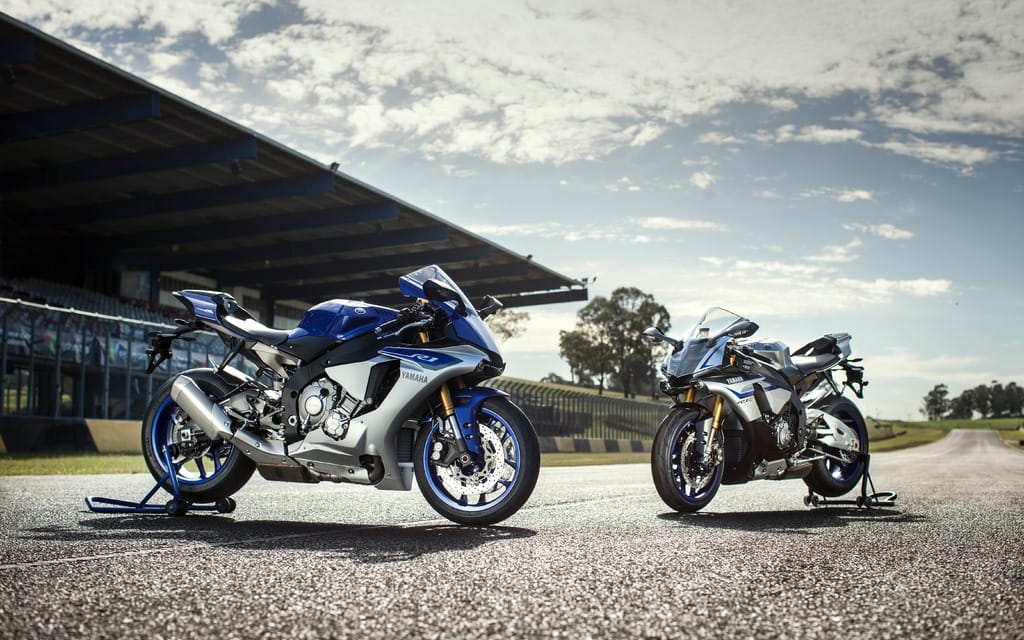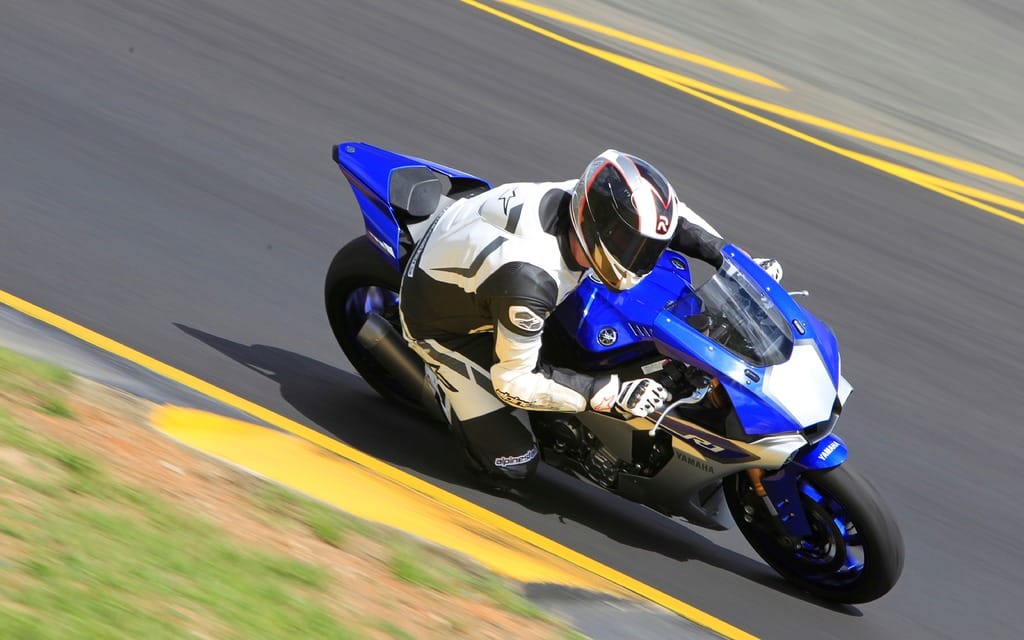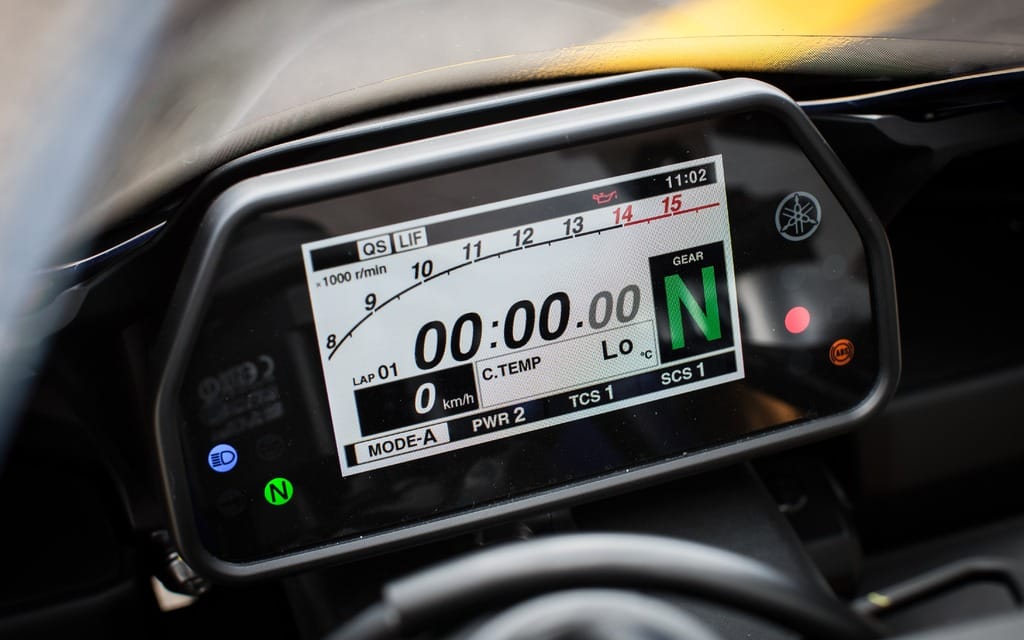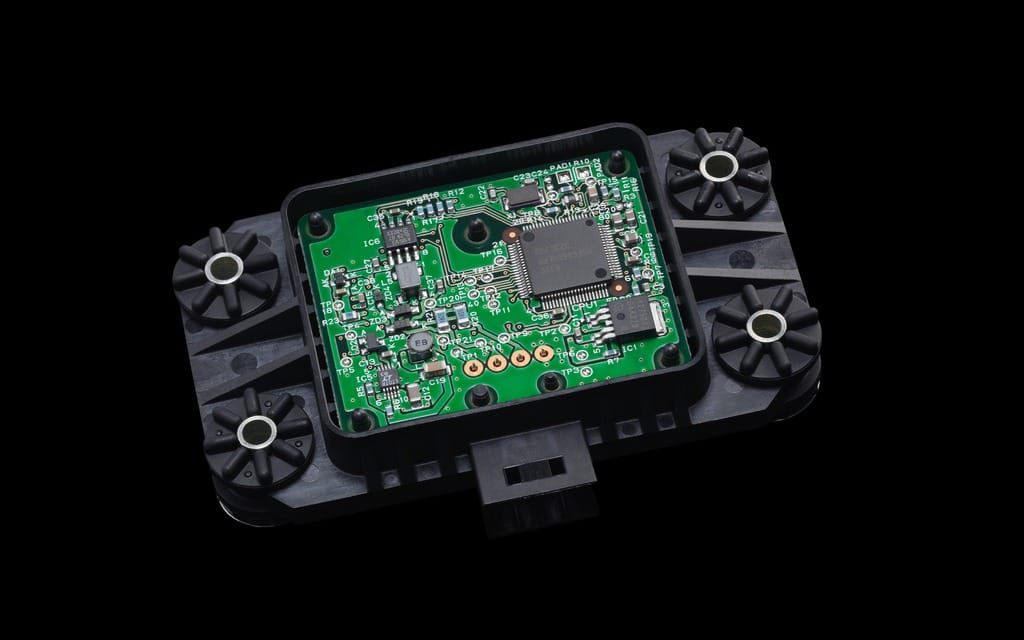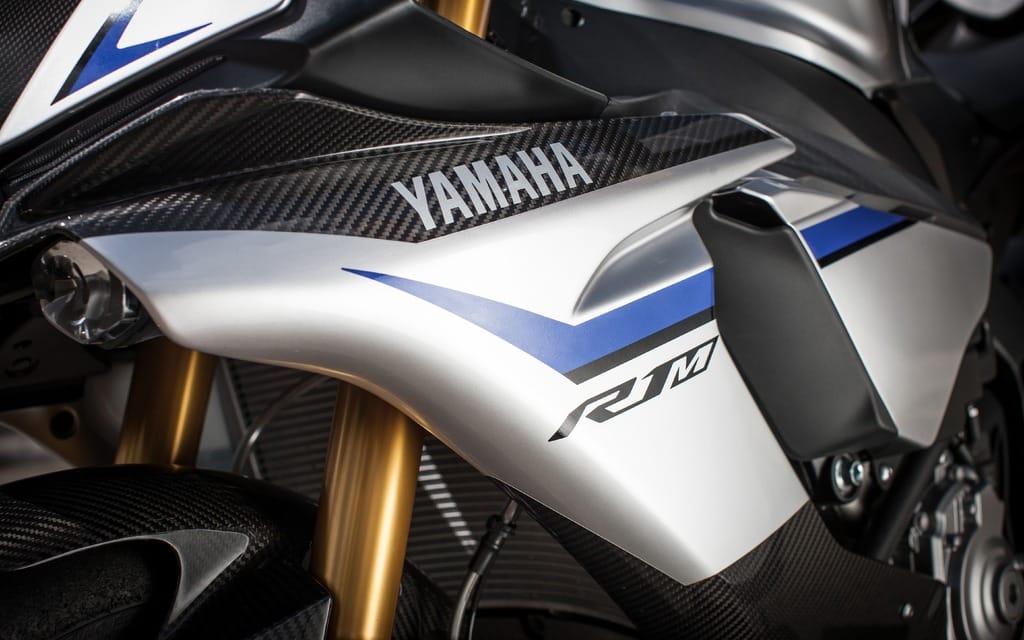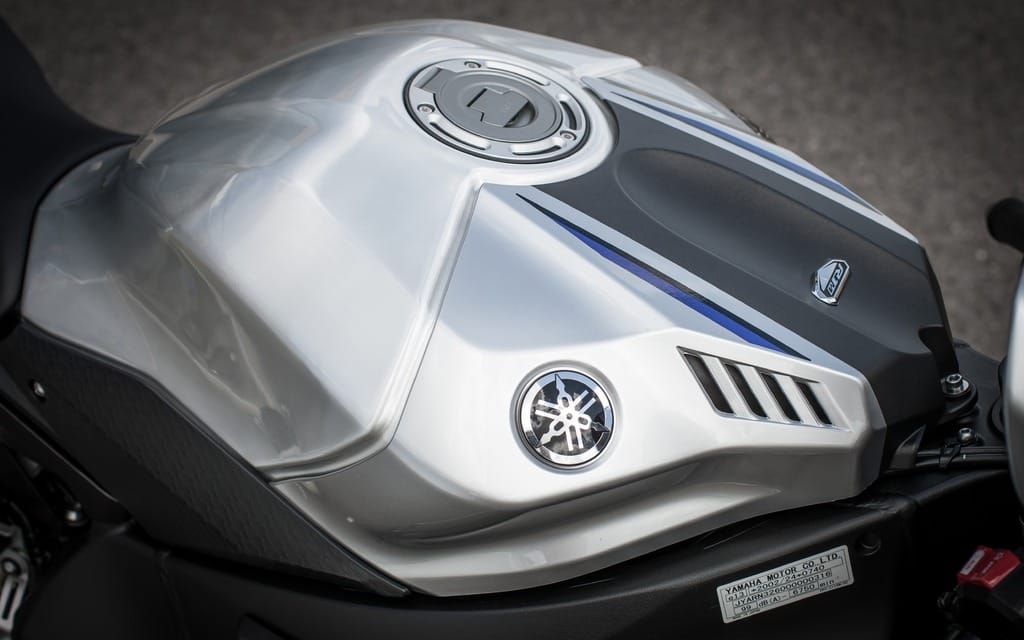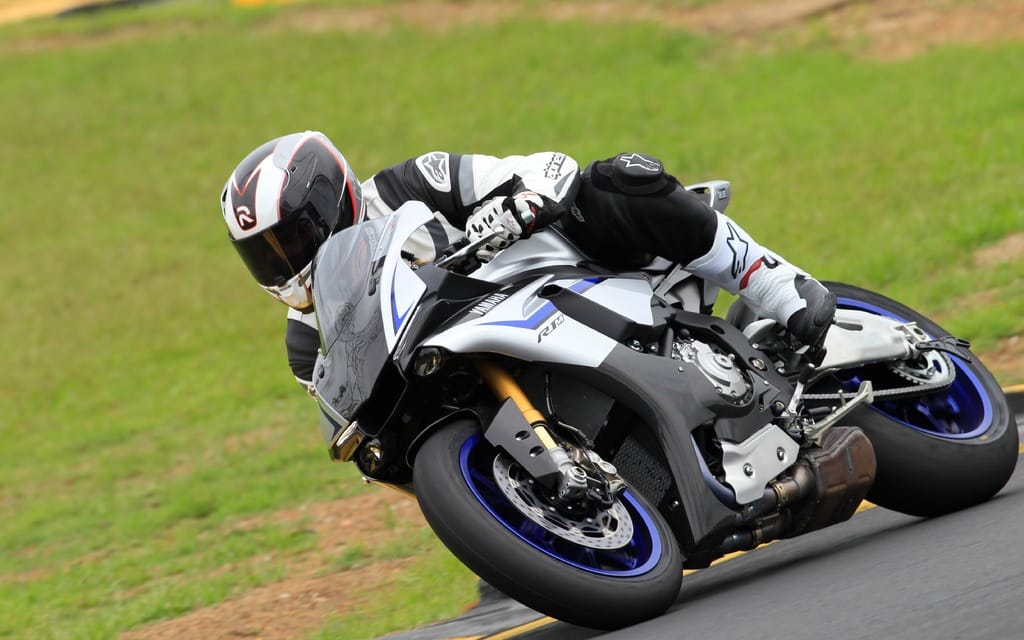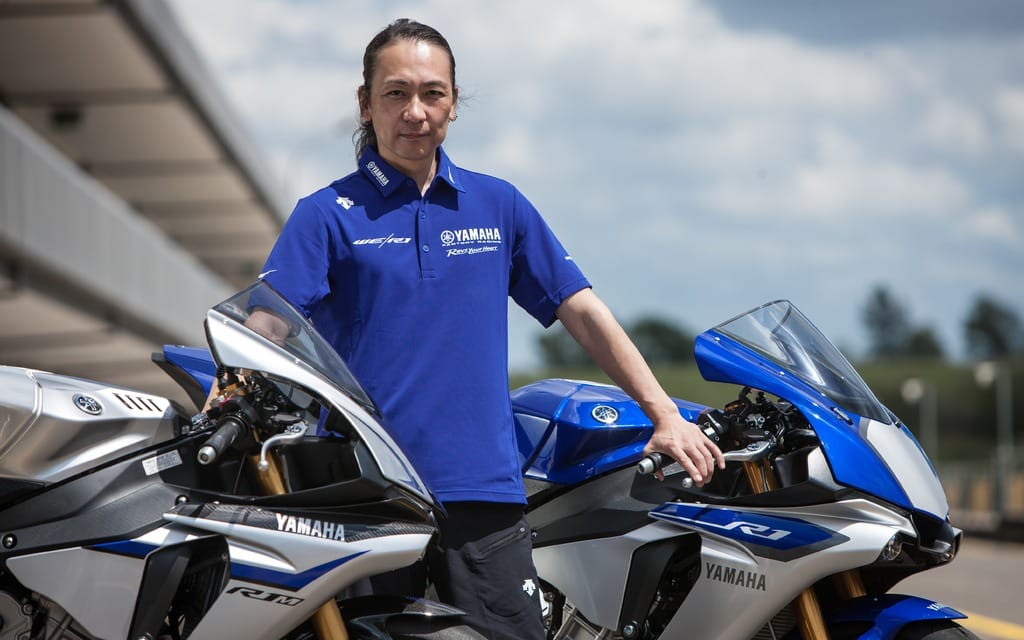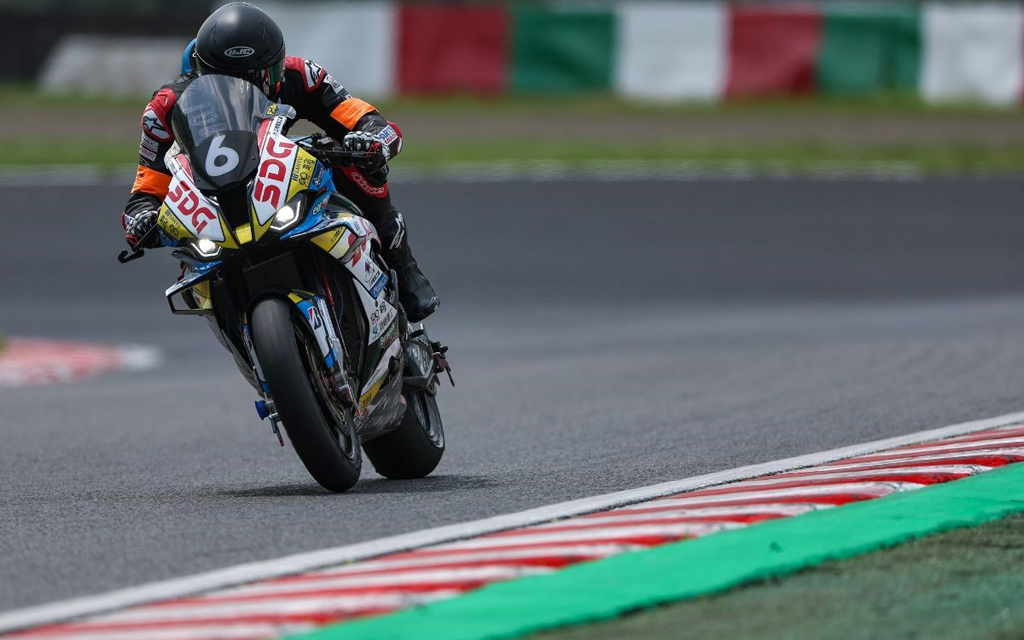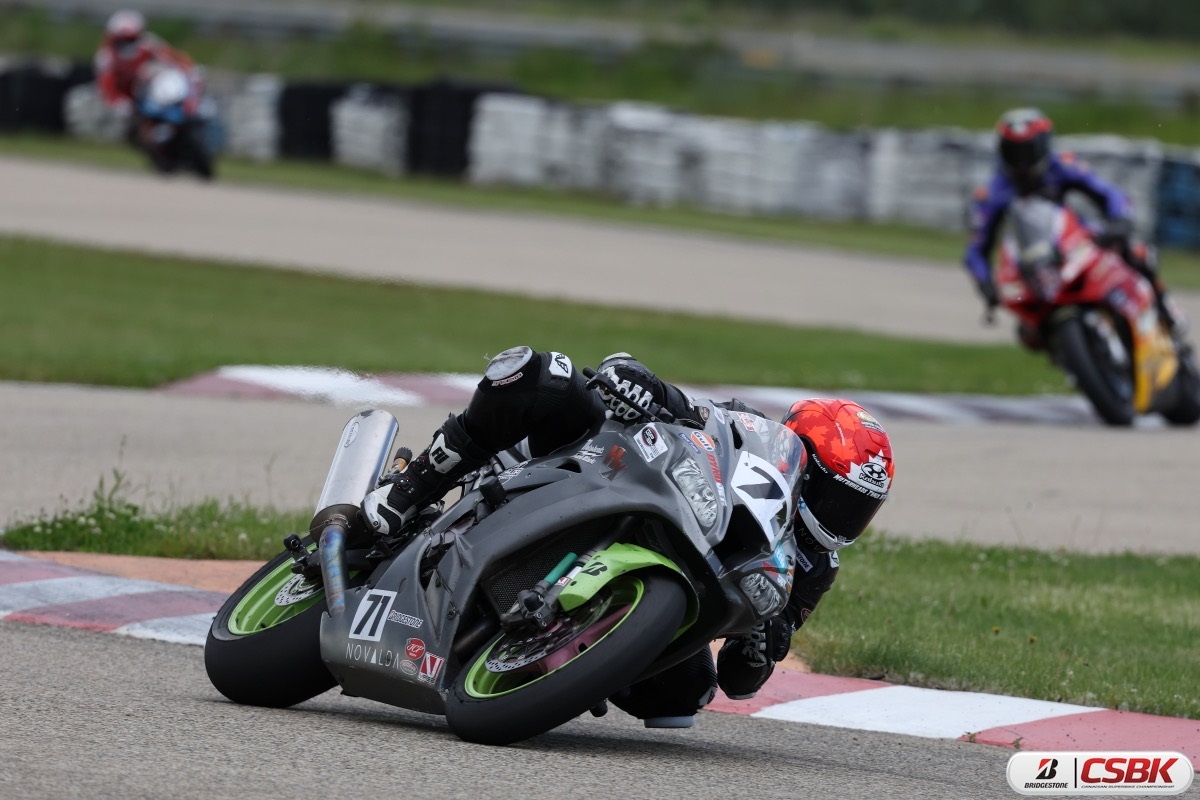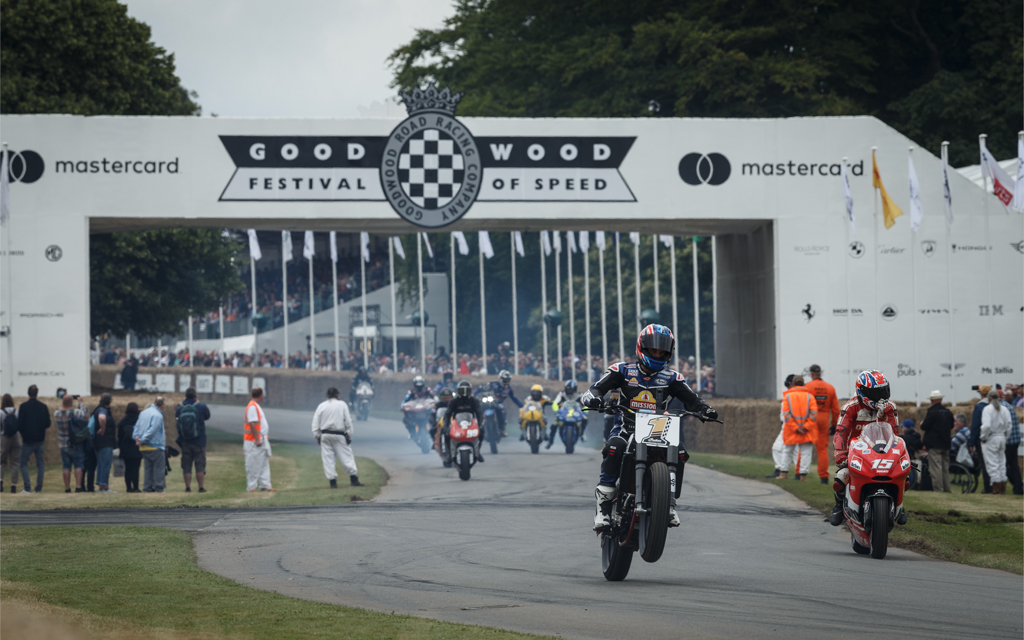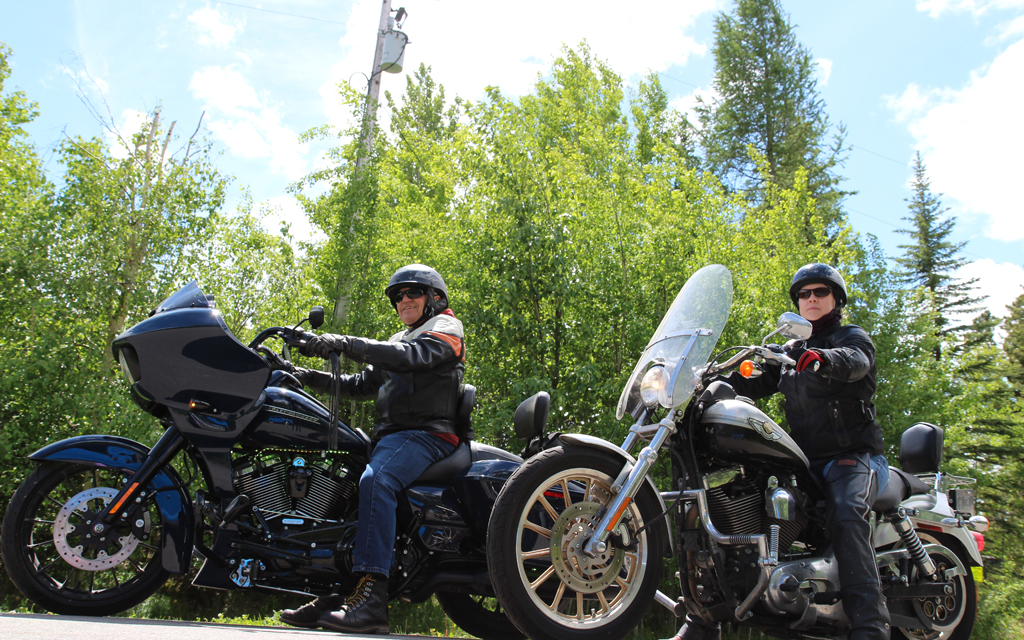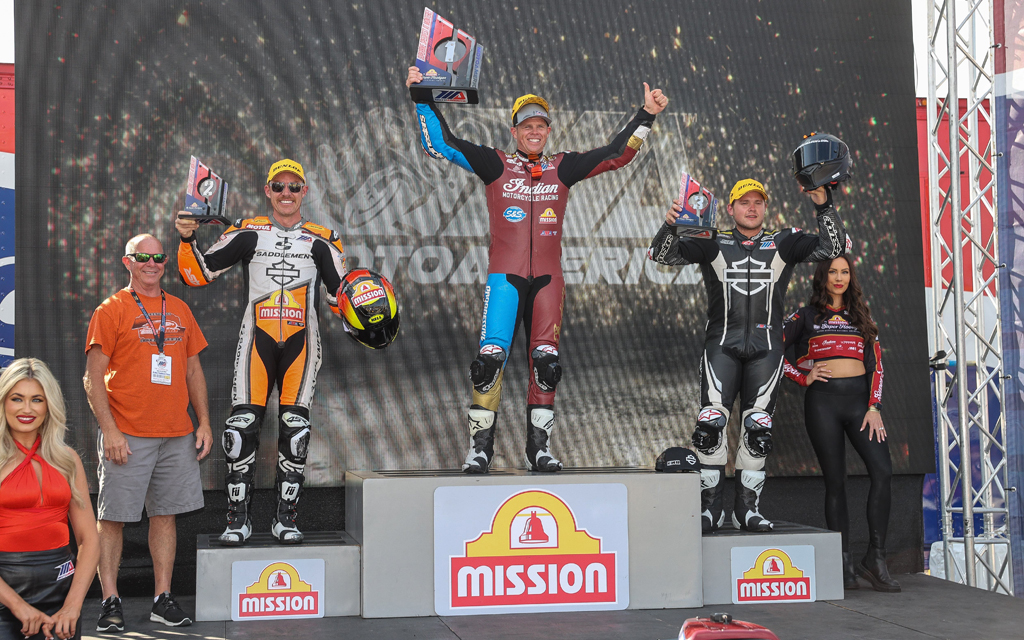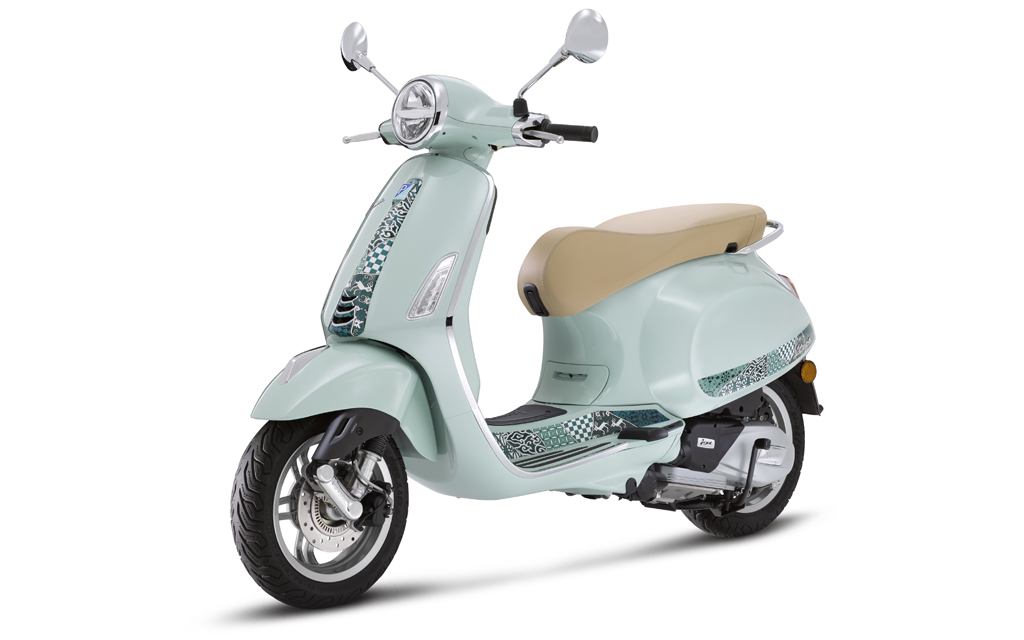MotoGP for the masses
I’m queued up on pit lane at Australia’s Sydney Motorsport Park (SMP) for the launch of Yamaha’s all-new YZF-R1. Randomly drawn numbers have gridded me as the lead rider of our press launch session. We’re to maintain order and follow a Yamaha staffer for one lap before cutting loose on the circuit. I’m tense. It’s winter and I haven’t ridden in more than two months. It doesn’t help that pro racers Cameron Donald (Isle of Man TT regular), Steve Martin (World Superbike vet and World Endurance champ), and Josh Brookes (British Superbike competitor) are lined up behind me. With the obligatory lap-in-sequence completed, the hotshots filter past and I settle into the bike and learn the track. Space and time equal improvement and speed, and the R1 facilitates the learning brilliantly.
Good bikes take time, but the length of the R1’s gestation was becoming ridiculous — especially in a segment that demands constant evolution. Yamaha’s top-of-the-line superbike last received a full overhaul in 2006, and since then changes have come incrementally — new electronic controls (ride-by-wire throttle and a chip controlled intake system) in 2007, the crossplane crankshaft configuration in 2009, and then, in 2012, the adoption of traction control. And then we waited.
Meanwhile, European manufacturers continued incorporating state-of-the-art technology into their superbikes — think of the sophisticated electronics of the Ducati Panigale, Aprilia RSV4, or, Everyman’s Superbike, the BMW S1000RR. (The latter with rear wheel horsepower securely into the 190s.) The 2015 R1 — and its higher-specification sibling, the R1M — debuts a dramatically different appearance, all-new internals, and MotoGP-derived gadgetry.
My morning track sessions are on a base R1 wearing Bridgestone RS10R supersport tires (RS10s come stock). For the first session the R1 has the standard ECU, which has a top-speed limiter (relax, it’s good for 299 km/h, sufficient for that early Sunday nip out of town on Macleod Trail) and, to meet North American noise requirements, the engine detuned for claimed crankshaft horsepower in the mid-190s. The rest of the day is spent with a “circuit” ECU, available as an option (figure on $300 to $400). It removes the speed limiter, deactivates linked braking and rear ABS, sets front ABS to circuit spec, and restores the R1 to its claimed full 200 crankshaft horsepower.
And an R1 at full power is righteous, man. I spend the first session in mode C (early electronic intervention and softened power delivery) feeling out a challenging track with tight esses, fast sweepers, blind crests, off-camber corners, hard acceleration and braking zones, and an absurdly tight hairpin. After staying out of the weeds (the forgiving R1 has more to do with that than I do), the next two sessions are split between modes B and A (less electronic intervention and harder power delivery in B, and even less intervention and unrestrained power in A). But forget all that. What matters is that the sensations are sensational.
First, there’s the acceleration. The quickshifter nips up through the gearbox effortlessly and the R1 surges forward at an alarming rate — within two blinks I hit 280 km/h on the front straight (and that’s in fifth, with plenty more to come). Except it doesn’t feel that fast because of the calm created behind a new fairing and windscreen inspired by the M1, Yamaha’s MotoGP machine. The cockpit is roomier than the old R1’s (an additional 10 mm pegs-to-seat and 55 mm more in seat-to-handlebar distance) allowing even a lumberjack like me to tuck in.
At such speeds, corners come quickly. Clutch pull is light, downshifts are sharp, and the R1’s midrange is meaty enough — flawless fuelling helps too — that some downshifts are elective rather than compulsory. You can carry a higher gear through a corner, but you can only carry so much speed; thankfully, the R1’s brakes are ferociously good. An all-new front stopper uses 320 mm rotors and powerful monobloc four-piston calipers. A two-fingered touch is all you’ll need, and modulation is incredibly precise. During the entire day ABS only intervenes once, and at that only in my first session (I’m in high-intervention mode C) when I overshoot the hairpin. It steps in smoothly and allows me to safely negotiate the corner. (I doubt it would’ve intervened at all in the more permissive B or A mode.)
The bike’s handling is impeccable. At 199 kg soaking wet, the R1 is light (cast magnesium wheels help) and turns in very quickly. A wide, flat, firm seat, which melds perfectly with the 17-litre aluminum fuel tank, allows for easy side-to-side movements. The base bike comes with fully adjustable KYB suspension bits that are far from basic. Front end feel from a 43 mm inverted fork is excellent from entry to exit, and the R1 remains predictable and planted even in SMP’s tightest sections.
Giving it stick on exits elicits a flicker of lights from the dash that tells me traction and slide control are stepping in, though modulation is so seamless all I feel is a smooth surge forward. (I only occasionally provoke such intervention in mode B, and never in A. The rate at which you must ride for these systems to intervene in their most permissive settings is — for now — beyond me, and, I suspect, beyond most riders.) Likewise, Lift Control modulates power wheelies with such precision that even a ham-fisted novice can look like an old hand, gracefully raising and lowering the front wheel. Riding a superbike at speed on a track is intimidating, but the R1 almost makes it easy. Almost.
And just when you think things couldn’t get any better, there’s the R1M. Unbelievably, it takes the R1 package and refines it further with stunning details (hand-polished and clear-coated fuel tank and swingarm and sinuous carbon fibre fitments), and, more importantly, Öhlins electronic suspension, which continuously and automatically adjusts compression and rebound rates front and rear. The result? The R1M consistently feels more dialed in than the R1 — because it is. (Part of that can be attributed to running afternoon sessions on sticky Bridgestone V02 slicks, but the bike’s sophisticated suspension system deserves much of the credit.) For racers who want to make minute adjustments, or for those who can’t leave well enough alone, the R1M’s suspension can be fine-tuned.
Electronic sophistication doesn’t stop there. The R1M also comes with a GPS-equipped Communication Control Unit (it’s an option for the R1), which, in conjunction with the Inertial Measurement Unit (IMU), allows ride data to be recorded and downloaded wirelessly to the Yamaha Y-TRAC app on a smart device, where it can be overlaid on satellite maps. That means that while the missus is screaming at you to put down that tablet at the dinner table, you can figure out how to save two- tenths in the second sector at your Shannonville track day — all while her spittle is still airborne.
Truly, the R1M is MotoGP for the masses, as close as you can get to putting Rossi’s M1 in your garage — and it’s street legal — and yet the standard R1 is no slouch itself. After five sessions I’m nowhere near the likes of Donald, Martin, and Brookes, but I’m much more comfortable riding a superbike at speed than I expected. For we mere mortals, the reassurance and flawless function of the R1’s electronics are a boon to be embraced.
But are people ready for such sophisticated speed? According to Yamaha Canada’s John Bayliss, the public is ready, willing, and positively clamouring to pay $22,999 for the R1M. Sadly, many will be disappointed. Each R1M destined for Canada is spoken for; it was sold out by the time the winter motorcycle show circuit left Edmonton in mid-January. Granted, it’s a limited-run model, with fewer than 100 slated for our shores; it was bound to sell out. (Some dealers may have put deposits down in the name of “John Doe,” meaning there could be ownerless R1Ms out there. Make discreet inquiries at your local dealer. And bring cash.)
This has implications for R1 sales, too. Many would-be R1M buyers, says Bayliss, are now settling for the $18,999 R1 (if that’s “settling” I’m all for it), which means its numbers are dwindling quickly. Even if you’re too slow to react and out of luck for 2015, don’t despair; if the new R1 has taught us anything, it’s that good things are worth waiting for.
The lowdown on the hard parts
A new bike isn’t really new unless you tinker with its ticker. The R1’s 998 cc inline four still uses Yamaha’s crossplane crankshaft design, but the new mill is slimmer, trimmer, and more powerful than its predecessor. Friction losses and rotational mass are reduced, new camshafts have more lift and revised timing, the lubrication system is new, the clutch is lighter and more compact, and a new transmission has revised gear ratios (first through fourth slightly lowered from last year’s). And, a first for a production bike, the R1 receives fracture-split connecting rods made of titanium (40 percent lighter than steel). Magnesium engine covers and aluminum engine bolts contribute to a weight savings of four kilos.
A new aluminum deltabox frame cradles the engine, with rigidity and balance meant to mimic the M1 racer. It’s compact, and, says Yamaha, set for circuit riding, with a focus on corner entry and front-end feel. The subframe is magnesium and the aluminum swingarm uses an upward truss-type design to make room for the mid-ships muffler. The swingarm is 15 mm shorter than before, which Yamaha says improves traction on corner exits.
Paradise by the dashboard light
The R1 has a 4.2-inch thin-film-transistor instrument panel that can be swapped between white and black backgrounds. It can also be switched between street and track layouts. The latter shortens the tach from 8,000 to redline, and illuminates the lap number, the lap time, and displays the selected gear prominently. Both show riding mode and power map, as well as traction control and slide control settings. It sounds complicated, but the system is intuitive and easy to operate using a mode button and toggle switch on the left grip and menu scroll wheel on the right. Who knew superbike controls could be so simple?
Electronic elation
The brain behind the new R1’s electronic wizardry is the proprietary six-axis Inertial Measurement Unit (IMU) first introduced on Yamaha’s M1 MotoGP machines in 2012 (Jorge Lorenzo won the championship that year). Now it’s on a production bike — who says racing serves no purpose?
The IMU uses a gyro sensor to measure pitch, roll, and yaw, and a g-sensor to measure forward-backward, up-down, and right-left g-forces. It does so continuously, meaning that at any given time the unit knows exactly what the motorcycle — and by extension, its rider — is doing. If you raise your butt cheek to pass gas halfway down the front straightaway, the R1 will sense it.
This information allows a multitude of high-tech safety nets and functions to be executed with exactitude. There’s lean-angle-sensitive traction control and, working in conjunction with traction control — and a first on a production bike — a slide control system lifted directly from the 2012 M1. Slide control modulates engine output when it detects the rear wheel sliding out during acceleration. Then there’s wheelie control, launch control, and a brake system that links the brakes front-to-rear, but is sensitive to lean angle (more lean, less rear brake). The level of intervention of all of these systems can be adjusted, or, if you have a death wish, deactivated. There are also four power modes varying the aggressiveness of throttle response, one of which reduces peak power. To protect your sanity from the sheer magnitude of adjustability, the system comes (amen) with four factory presets.
Paradigm shift
The development focus for the R1 had previously been street first, track second. This formula was successful in both spheres; the R1 has been a sure-selling street model and secured racing championships (notably, the 2009 World Superbike crown). But, as with any design, the same-old can’t stay the same forever.
This time it’s different. In an effort to inject life into Yamaha’s lineup, the R1’s development focus is reversed. “This bike is built to win on the racetrack,” says Hideki Fujiwara, project leader for the 2015 R1. Part of the development process involved riding Valentino Rossi’s M1, something Mike Ulrich, a Yamaha test pilot, relished. “With the new R1, the track rider or the racer are our top priority,” Ulrich says. Proof of concept: Rossi as well as AMA champ Josh Hayes were involved in development.
“We want to enable riders to concentrate fully on outracing rivals on the circuit,” says Fujiwara. “On the track is where riders evaluate this bike.”
With such stated track emphasis, we wondered if Yamaha Canada had plans to compete in the Mopar Minivan Canadian Superbike Series. No plans yet, say Yamaha, but we suspect Brett McCormick could be coaxed into a hiatus from his engineering degree for a fraction of what Yamaha spends on its motocross team. Not that there’s anything wrong with motocross — not at all — we’re just floating the idea. Back to you, boys.
